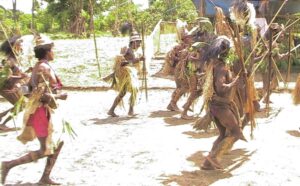Welcome to ‘Exploring the Jungle,’ a trek into the unknowns of CAD
A columnist describes the symptoms she experienced ahead of her diagnosis

The noise was horrendous. People were dressed in penis gourds and grass skirts, all carrying some type of weapon — spears, bows, arrows, machetes. Many had boar tusks inserted through their nasal septum. As they danced and hollered around the small jungle plane I’d flown to this small village in the middle of the Papuan jungle, I wondered if I’d be eaten. Stories by Canadian missionary Don Richardson flitted through my mind.
Papua, a province of Indonesia known as Irian Jaya in 1995, was renowned for its rugged territory, jungle flora and fauna, and — gulp — cannibalism! There was still so much to learn about it. I’d looked at a pilot’s map of the island, and large tracts of land were labeled “unknown.” There was so much about my new life as a teacher of missionary children that was, as yet, unknown.
A different kind of unknown
In 2018, I stepped off another plane, this time returning to the U.S. from Indonesia, and collapsed into a waiting wheelchair. The very kind airline assistant pushed me through the flurry of immigration, baggage collection, and customs and toward my daughter’s car. I was back in the familiar territory of the South, but I was entering another unknown, unexplored world. I didn’t know it at that moment, but I’d hit the lottery. I had cold agglutinin disease (CAD), a rare autoimmune disorder in which the body attacks red blood cells at low temperatures.
When I was diagnosed later that year, a major piece of advice was “don’t get cold.” Did that mean never going outdoors from October through March? Did that mean I could still go outside if I bundled up? What would trigger hemolysis, or the breakdown of my red blood cells? There was so much about my new life with cold agglutinin that was also, as yet, unknown.
Medical personnel frequently ask me, “When did you first feel symptoms?” I usually sigh. That’s a hard question. I had low body temperatures in the 1980s. Did my CAD manifest that early? Does it even matter?
Perhaps I first felt symptoms in the late 1990s and early 2000s. I was tired a lot and had frequent headaches. I’d feel feverish, but never had a temperature higher than 99 F. Malaria is endemic here in Indonesia, with similar symptoms to what I was experiencing. To check, I’d send a blood smear to a laboratory. The results frequently would return as “negative for malaria, but there is a high white blood cell count.” Something unknown was going on.
And it continued that way. As the years went on, I became more and more tired and dealt with many unexplained symptoms. I had periodic episodes of shortness of breath, where it felt like an elephant was sitting on my chest. I even went to the emergency room thinking I might be having a heart attack. Negative. I couldn’t sing hymns in church because my breath wouldn’t move past my vocal cords. I’d have unexplained abdominal pains. The tests for appendicitis were also negative. It was unknown why I had a high white blood cell count.
Throughout this period, I had multiple complete blood tests done in varied locations worldwide, as I was traveling quite a bit. But almost every time, in every place, the laboratories would report, “We need to collect more blood. The red blood cells were damaged, and we couldn’t get a reading.” Having the same report from so many different labs was quite a coincidence — or was it? Something unknown was going on.
Finally, things came to a head in 2018. I became very ill with food poisoning in late April. At that point, along with the anemia I know now was caused by CAD, I could barely walk. I was in Papua, Indonesia, teaching sixth graders at Hillcrest School. Doctor friends in the U.S. urged me to come home. Three days after I decided to leave, I got on a plane and began the 50-hour journey home. I was traveling into unknown medical territory.
I’ve been exploring the unfamiliar territory of cold agglutinin ever since. CAD research and information have increased in the intervening years. In February 2022, the first therapy for CAD was approved. This breakthrough treatment wasn’t accessible when I was diagnosed just a few years earlier.
I look forward to sharing the ups and downs of my everyday life as I explore the territories on the CAD map labeled “unknown.”
Note: Cold Agglutinin Disease News is strictly a news and information website about the disease. It does not provide medical advice, diagnosis, or treatment. This content is not intended to be a substitute for professional medical advice, diagnosis, or treatment. Always seek the advice of your physician or other qualified health provider with any questions you may have regarding a medical condition. Never disregard professional medical advice or delay in seeking it because of something you have read on this website. The opinions expressed in this column are not those of Cold Agglutinin Disease News or its parent company, Bionews, and are intended to spark discussion about issues pertaining to cold agglutinin disease.








Leave a comment
Fill in the required fields to post. Your email address will not be published.